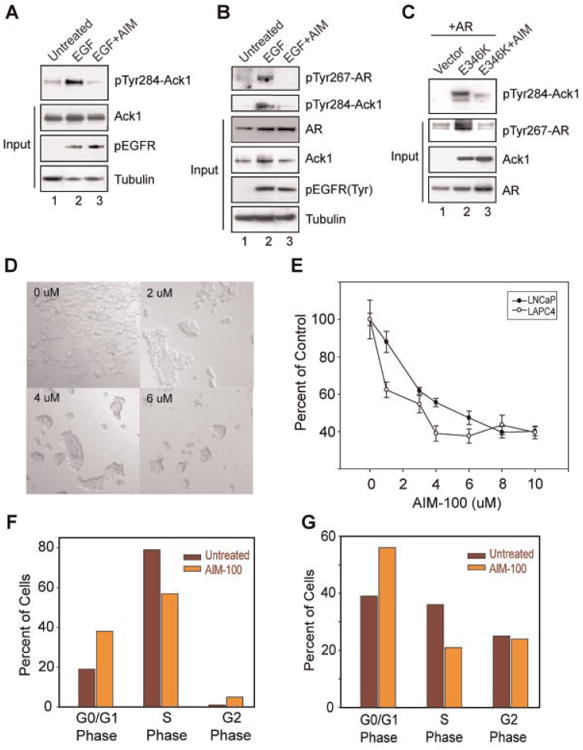Fig. 4.

Ack1 small molecule inhibitor AIM-100 inhibited pTyr284 -Ack1 expression. A: Serum-depleted MEFs were treated (or untreated) with EGF (10 ng/ml, 10 min) and AIM-100 (0.8 μM, 16hr), and lysates were immunoblotted with pTyr284-Ack1 antibodies (top panel). B: Serum and androgen-depleted LAPC4 cells were treated (or untreated) with EGF (10ng/ml, 40 min) and AIM-100 (0.8 μM, 16 hr). Cell lysates were immunoprecipitated using pTyr antibodies, followed by immunoblotting with pTyr267-AR (top panel) and pTyr284-Ack1 antibodies (second panel). C: HEK293 cells were transfected with empty vector or Ack1 mutant E346K and Flag-tagged AR construct, treated with AIM-100 (1.6 μM, 16 hr) and whole cell lysates were immunoblotted with pTyr284-Ack1 antibodies (top panel). Cell lysates were also immunoprecipitated using pTyr antibodies, followed by immunoblotting with pTyr267-AR antibodies (second panel). D: LNCaP cells were untreated or treated with AIM-100 (2–6 μM) for 48hr and cells photographed using differential interference contrast imaging. AIM-100 treatment significantly inhibited the growth of cells. E: LNCaP and LAPC4 cells were untreated or treated with AIM-100 (1–10 μM) for 72 and 108 hr, respectively, and MTTassay was performed. Experiment was performed twice with eight replicates, a representative data set is shown. F: Cell cycle analysis by flow cytometry. LNCaP cells were untreated or treated with AIM-100 (3 μM) for 72hr. Cells were stained with propidium iodide and DNA content was measured. Experiment was performed thrice, and representative data set is shown. G: LAPC4 cells were untreated or treated with AIM-100 for 72 hr. Cells were stained with propidium iodide and DNA content was measured by flow cytometry. Experiment was performed thrice, a representative data set is shown (with 10,000 cells counted). [Color figure can be viewed in the online issue, which is available at www.interscience.wiley.com.]
